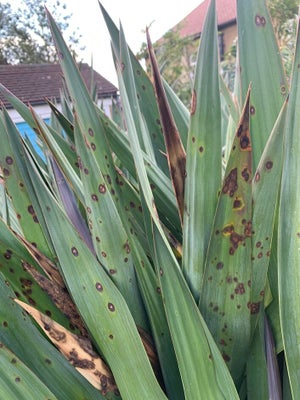
Quick facts
Common name - Yucca leaf spot
Scientific name - Predominantly Coniothyrium concentricum (syn. Microsphaeropsis concentrica)
Plants affected - Yucca and some other succulents including Agave and Dracaena
Main symptoms - Brown leaf spots, scorched appearance to leaves
Main causes - Fungi
Most active - Year round, as Yucca retain their leaves
What is Yucca leaf spot?
Yucca leaf spot is a fungal disease of Yucca species, and some other including Agave and Dracaena.
Coniothyrium concentricum (syn. Microsphaeropsis concentrica) is the most common cause of Yucca leaf spots in the UK. Others have been recorded, including Colletotrichum species, but they are much less common. All of these fungal species cause grey-brown spotting on the upper surface of leaves, and leaves can often appear scorched.
Symptoms
You may see the following symptoms:
- The infection first appears as tiny clear spots in the older leaves. The lesions initially turn yellow and finally purple/brown as they mature. The lesions are generally oval and scattered across the upper leaf surface.
- With a Coniothyrium concentricum infection, after about 4 months, tiny black fruiting bodies of the fungus form in concentric rings on the sunken lesions.
Leaves can often appear scorched, especially at the tips.

Control
The RHS believes that avoiding pests, diseases and weeds by good practice in cultivation methods, selection, and encouraging or introducing natural enemies, should be the first line of control. If chemical controls are used, they should be used only in a minimal and highly targeted manner.
Non-chemical control
- Remove heavily infected leaves if feasible to prevent the spread of spores to new foliage.
- Reduce overhead watering and/or provide protection from rain, which can help to reduce spores being splashed to new leaves.
- The fungus most likely persists on fallen leaf debris, so clear the area of fallen leaves, and destroy the leaves rather than adding them to your .
Many plants suffer from more severe leaf spot infections when they are under general stress. Ensure that the plant is appropriately watered and fed to help improve its' overall health.
Fungicides
The RHS recommends that you don't use fungicides. Fungicides (including organic types) may reduce , impact soil health and have wider adverse environmental effects. If you do intend to use a fungicide, please read the information given in the link and download below to ensure that use, storage and disposal of the product is done in a responsible and legally compliant manner.
The products listed in the ‘Fungicides for gardeners’ document below are legally available for use by home gardeners in the UK. This information is provided to avoid misuse of legal products and the use of unauthorised and untested products, which potentially has more serious consequences for the environment and wildlife than when products are used legally. Homemade products are not recommended as they are unregulated and usually untested.
There is no specific information available on the efficacy of any home garden fungicide against Yucca leaf spot.
Download
Fungicides for gardeners (Adobe Acrobat pdf document outlining fungicides available to gardeners)
Link
Biology
The precise conditions for spread of the leaf spot disease are unknown, but it is favoured by wet weather conditions. Spores are likely to be splashed around by rain droplets, to produce new infections if the leaf surface stays wet for an extended period. The fungi probably persists on fallen leaf debris.





